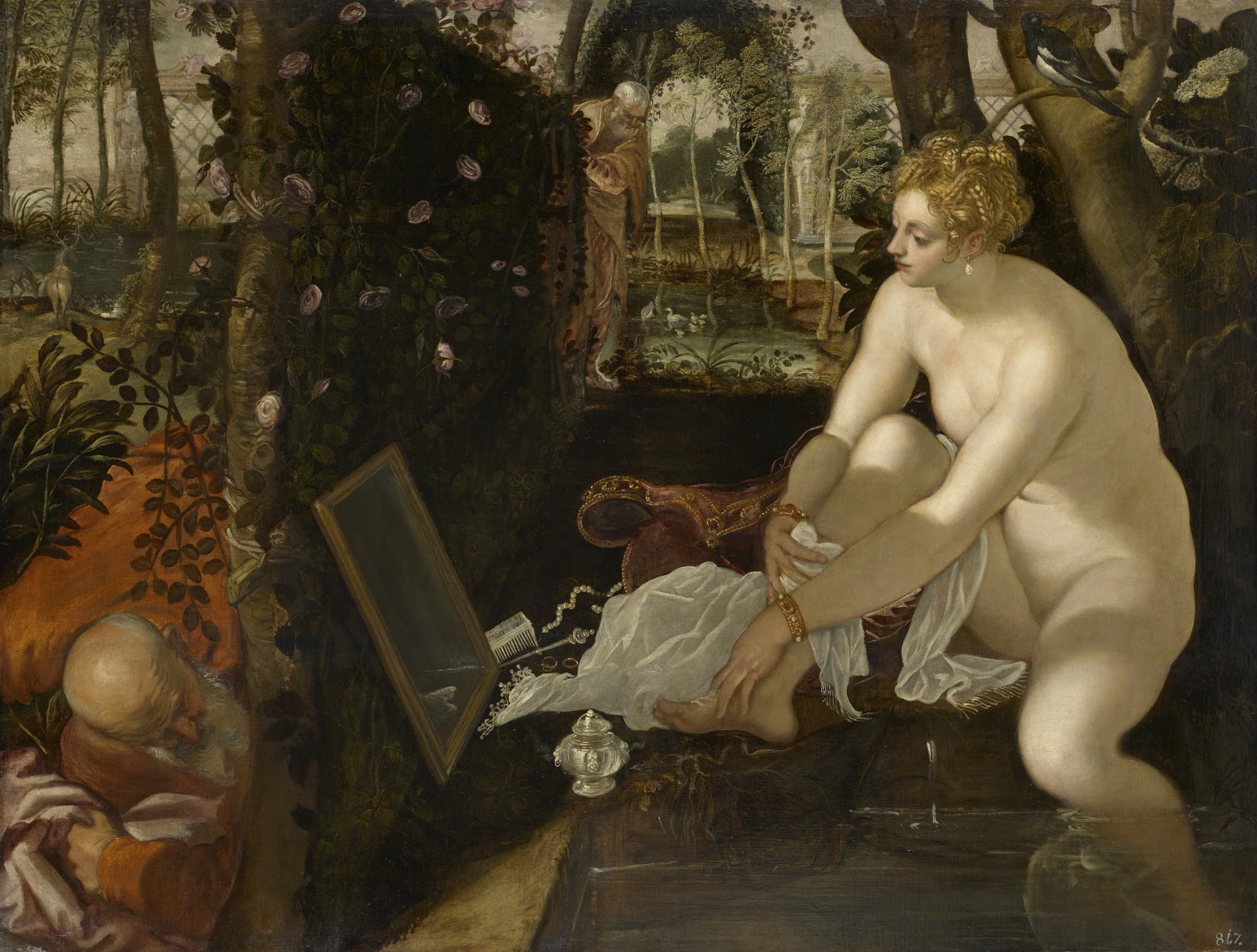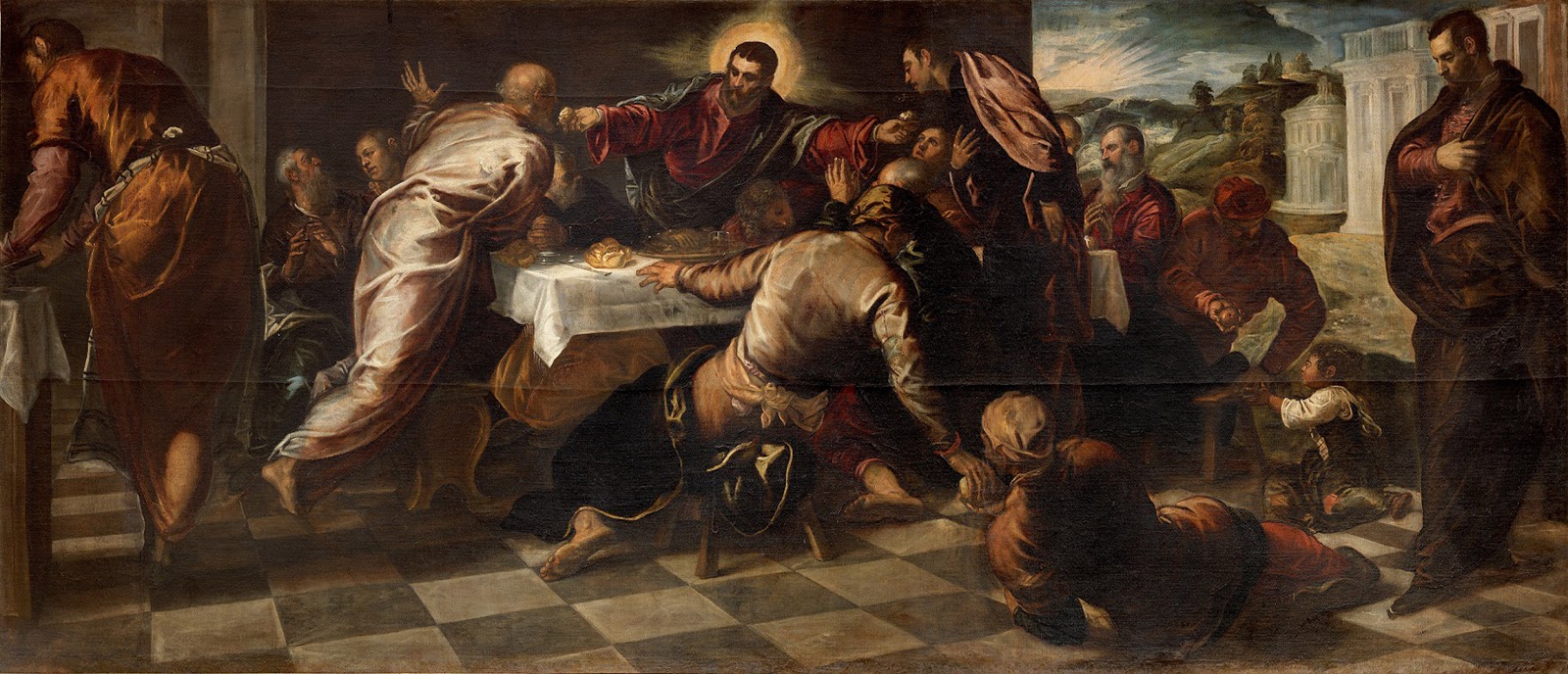Tintoretto Arrives in Rome
I'll never forget the first time I saw a Tintoretto painting. I was in Venice for Carnival with an old friend nearly ten years ago, and we decided to visit the Scuola Grande di San Rocco. I was blown away by the immense output of this prolific painter. His works seemed to cover every wall and ceiling in each one of the countless rooms. The drama, the color, the detail; it was dazzling. Now, I have to admit, all those years ago I was not the formidable Italian art expert I am today (I would put a winky face here to insure that my written sarcasm was recognized as such, but I cannot abide emoticons in anything but text messages, and not much there, so I'll just have to hope my facetiousness came across nonetheless).
Embarrassing as it is to admit, at that time I had only ever heard of the Scuola Grande di San Rocco because of Woody Allen. In one of the lesser acclaimed (but perhaps my personal favorite) of his films, Everyone Says I Love You (1996), Allen travels to Venice where he tries to impress a beautiful art historian (Julia Roberts) by showing off how well he knows her favorite painter, Tintoretto. In reality he just rattles off some lines he has memorized from an art book. I know that must sound like a pretty lame plot (it's just a sub-plot, I assure you) but it was executed with such classic Allen style that it makes me laugh just thinking about it. The scene in question takes place at, you guessed it, the Scuola Grande di San Rocco, and as a life-long Woody Allen fan, I made sure to visit. Little did I know how right Julia Roberts('s character) was about Tintoretto...
The newest exhibit in Rome, opening tomorrow at the Scuderie del Quirinale, is also the first major monographic exhibition of the works of Tintoretto in Italy. Like Guercino, Tintoretto was also nicknamed for a peculiarity: his father was a dyer, or tintore, hence Jacopo Robusti (or Comin, as his true last name has recently been discovered to have been) became known as the "little dyer". Not unlike Michelangelo, who claimed to have drunk in his talent for cutting stone with his wet nurse's milk (she had come from a long line of stone masons), perhaps Tintoretto's brilliant use of color was born of his learning the art of dyeing at his father's knee. In fact, when Tintoretto was only 14, his father noticed his natural ability at painting and sent him to toil in the great Titian's studio. He only lasted ten days and the master kicked him out. Some say he was jealous of the boy painter, others claim it more likely he saw his work as so radically different that there was no point in him taking the younger artist on as a student. Tintoretto turned out to be a mostly self-trained artist, perhaps due to this early rejection.
35 of Tintoretto's works are displayed, along with several others by his mentors and contemporaries, such as Titian, Parmigianino, Veronese and El Greco. The majestic (and enormous) work below opens the exhibit. It tells the story (taken from Jacobus de Voragine's medieval Golden Legend) of a slave about to be martyred for venerating the relics of a saint. St. Mark (patron saint of Venice) intervenes and renders the slave invincible. All weapons used against him are seen broken to bits. It is a powerful work to open the exhibit, but I feel that it might have been better saved until the end, as nothing else in the exhibit matches it.
A question that struck me when I saw this: Are there any other works (before the 20th century) that depict a saint (even a gloriously intervening one) in this position? Literally head over heels? I know Chagall got into that, but I don't think I've ever seen it in any of the great Italian masters' work (or Dutch for that matter!). Please illuminate me if I'm wrong!
About halfway through my visit, the exhibit's curator Vittorio Sgarbi sauntered past with a gaggle of journalists in tow, each one straining to get close enough to scribble down his every word. Not too keen to join the crush, the only thing I was able to hear was him calling one particular work (Vulcan Surprising Venus with Mars, not pictured) as Berlusconiano, because it was about "sex and not love". Not exactly an inspiring comment! So without the tutoring I was lucky to get at the Guercino exhibit, and with a lack of much scholarship on my part of the work of Tintoretto, part of me is tempted (simply for entertainment value, of course) to quote Woody Allen quoting that art book:
"The rapidity of his brush strokes, the chiaroscuro, outbursts of color, his capacity for controlled gesture..."
"How could I not appreciate a man who was short in stature but with a proud obstinate nature who painted outside the academic conventions of 16th century Venice?" (what I can't transcribe is his proud little giggle at his own brilliance; you'll just have to see the film for that gem). By the way, I have scoured the internet for a clip of that scene but I could only find it in Italian, and another thing I cannot abide is Woody Allen dubbed in Italian. So I will spare you. Oh, right, I'm supposed to be writing about Tintoretto, not Woody Allen. Where was I?
This action-packed Last Supper was recently restored on occasion of the exhibit, and it is fascinating (although I preferred the other version on display next to it, not pictured), but my question is, who is sleeping through all this ruckus under Jesus' left arm?
Unlike most of the other paintings, I didn't particularly like the one below. To be honest, the only thing that came to mind when I saw it was, I really hope heaven won't be so crowded! (I realize this is doubtless a blasphemous thought in many ways.)
This formidable artist's work can possibly best be summed up in his own words, by the sign he had hanging over his studio, "Il disegno di Michelangelo e il colorito di Tiziano" (the design of Michelangelo and the coloring of Titian). He apparently didn't think too little of himself!
If Woody Allen's and my words have left you thirsting for more substantial insight into the work of this "deep genius (the deepest)", there will be four opportunities to hear a real expert talk about some of the works on display. On 9 and 23 March as well as 4 and 18 May (all Fridays) at 7pm, lectures will be held in situ to explore four different paintings (one per lecture) by art historian and Tintoretto expert Anna Maria Panzera (who may or may not be played by Julia Roberts!) Admission to the lecture is included with purchase of exhibition ticket. I wouldn't miss it!
All images provided courtesy of the press office of Le Scuderie del Quirinale









